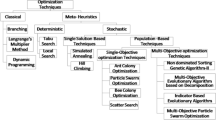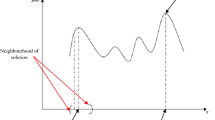Abstract
The problem of radio frequency assignment is to provide communication channels from limited spectral resources whilst keeping to a minimum the interference suffered by those whishing to communicate in a given radio communication network. This problem is a combinatorial (NP-hard) optimization problem. In 1993, the CELAR (the French “Centre d'Electronique de l'Armement”) built a suite of simplified versions of Radio Link Frequency Assignment Problems (RLFAP) starting from data on a real network Roisnel93. Initially designed for assessing the performances of several Constraint Logic Programming languages, these benchmarks have been made available to the public in the framework of the European EUCLID project CALMA (Combinatorial Algorithms for Military Applications). These problems should look very attractive to the CSP community: the problem is simple to represent, all constraints are binary and involve finite domain variables. They nevertheless have some of the flavors of real problems (including large size and several optimization criteria). This paper gives essential facts about the CELAR instances and also introduces the GRAPH instances which were generated during the CALMA project.
Similar content being viewed by others
References
C. Bessière, E.C. Freuder, and J.C. Régin (1995). Using inference to reduce arc-consistency computation. In Proc. of the 14th IJCAI, Montréal, Canada.
Christian Bessière and Jean-Charles Régin (1996). MAC and combined heuristics: Two reasons to forsake FC (and CBJ?) on hard problems. In Proc. of the Second International Conference on Principles and Practice of Constraint Programming, Cambridge, MA.
S. Bistarelli, U. Montanari, and F. Rossi (1995). Constraint solving over semirings. In Proc. of the 14th IJCAI, Montréal, Canada.
Ir. A.A.F. Bloemen (1992). Frequency assignment in mobile telecommunication networks. Technical report, Tech. Universiteit Eindhoven.
B. Cabon (1996). Problèmes d'optimisation combinatoire: évaluation deméthodes de la physique statistique. Thèse, ENSAE, Toulouse, France.
S. de Givry, G. Verfaillie, and T. Schiex (1997). Bounding the Optimum of Constraint Optimization Problems. In Proc. of the 3rd International Conference on Principles and Practice of Constraint Programming (CP-97), Schloss Hagenberg, Austria.
E.C. Freuder and R.J. Wallace (1992). Partial constraint satisfaction. Artificial Intelligence, 58:21–70.
S. Kirkpatrick, C. D. Gelatt, and M. P. Vecchi (1983). Optimization by simulated annealing. Science, 220:671–680.
A. Kolen (1994). A constraint satisfaction approach to the radio link frequency assignment problem. Technical Report 2.2.2, EUCLID CALMA project, 1994. Available at ftp://ftp.win.tue.nl/pub/ techreports/ CALMA/222.ps.
A. Kolen (1996). Results on infeasible instances of the RLFAP. Personal communication.
A. Kolen (forthcoming). A genetic algorithm for the partial binary satisfaction problem: An application to a frequency assignment problem. Technical report, University of Maastricht, Maastricht, The Netherlands.
T.A. Lanfear (1989). Graph theory and radio frequency assignment. Technical report, NATO, Allied Radio Frequency Agency.
A. K. Mackworth (1977). Consistency in networks of relations. Artificial Intelligence, 8:99–118.
C. Peterson and B. Soderberg (1989). A new method for mapping optimization problems onto neural networks. Int. Journal of Neural Systems, 1(1):3–22.
C. Roisnel (1993). Étude comparative d'outils de programmation par contraintes – synthèse et résultats.Technical Report ITES/555-93/RS 10539, CELAR.
T. Schiex, H. Fargier, and G. Verfaillie (1995). Valued constraint satisfaction problems: hard and easy problems. In Proc. of the 14th IJCAI, pages 631–637, Montréal, Canada.
T. Schiex, J.-C. Régin, C. Gaspin, and G. Verfaillie (1996). Lazy arc consistency. In Proc. of AAAI-96, Portland, OR, AAAI Press.
S. Tiourine, C. Hurkens, and J.K. Lenstra (1995). An overview of algorithmic approaches to frequency assignment problems. Technical report, EUCLID CALMA project, Eindhoven University of Technology.Available at ftp://ftp.win.tue.nl/pub/techreports/CALMA/overview.ps.
H.P. Van Benthem (1995). GRAPH: Generating radio link frequency assignment problems heuristically. Master's thesis, Faculty of Technical Mathematics and Informatics, Delft University of Technology, Delft, The Netherlands.
D.E. Van den Bout and T.K. Miller (1989). Graph Partitioning using Annealed Neural Networks. In Proc. of IJCNN-89, pages 521–528, Washington.
J.P. Warners (1996). A nonlinear approach to a class of combinatorial optimization problems. Technical Report 96–119, Delft University of Technology, Delft, The Netherlands. To appear in Statistica Neerlandica.
Author information
Authors and Affiliations
Rights and permissions
About this article
Cite this article
Cabon, B., de Givry, S., Lobjois, L. et al. Radio Link Frequency Assignment. Constraints 4, 79–89 (1999). https://doi.org/10.1023/A:1009812409930
Issue Date:
DOI: https://doi.org/10.1023/A:1009812409930




